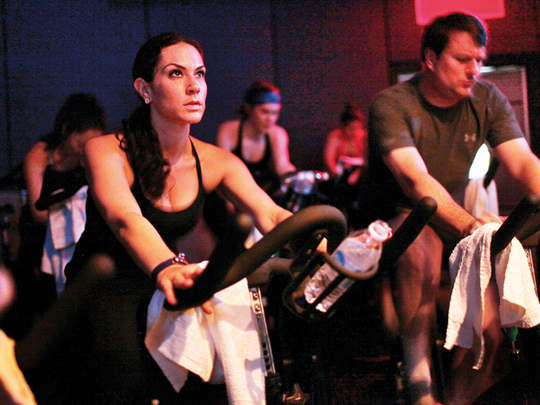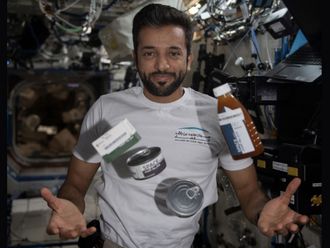
High-intensity interval training is one of the biggest trends in fitness, but it has always seemed a bit scary to me. To a mere mortal with achy knees and an ageing body, even the acronym — HIIT — sounded intimidating. But recently, I overcame my fears of intense interval training, which involves bursts of all-out exercise followed by brief periods of rest. When it was all over, not only did I feel great, but to my surprise, I enjoyed it.
And a wave of scientific evidence suggests that HIIT workouts are exactly the type of exercise a middle-aged, out-of-shape body should be doing. Research has shown that HIIT workouts are the best exercise at any age, and for older people especially, it’s the most efficient way to exercise and reverse the signs of ageing within cells. It’s also faster and more interesting than the hourlong slogs on the treadmill that many of us think we should be doing (but often don’t.)
So how did I overcome my fears about high-intensity training?
It began with a heart rate monitor. Alex Chriest, a fitness coach at the Johnson & Johnson Human Performance Institute in Orlando, showed me how using a heart rate monitor could make high-intensity exercise not only easier, but more fun.
Chriest, who has a doctorate in education, recommends a Polar heart rate monitor with a chest strap sensor and watch, though there are many other good brands that include a strap. (Wirecutter has reviewed the best wrist fitness trackers with heart monitors.) Just set the watch with your weight, height, age and gender and put it on your wrist. I wrapped the chest strap just at the base of my sports bra, and almost immediately, the watch began reporting my resting heart rate, which is around 80 beats a minute. (A normal resting heart rate ranges from 60 to 100 — a lower rate suggests better fitness and more efficient heart function.)
For my workout, I chose a stationary bike, but others in the group seminar I was attending chose a treadmill, stair climber or rowing machine. My first task was an easy warm-up for just three minutes. So far so good.
Next, Chriest issued a challenge. Push hard for three minutes. The goal was to push ourselves into a discomfort zone, but not a pain zone, and see how high we could push our heart rates. Three minutes? My legs were fresh, I hadn’t yet broken a sweat, so I knew I could handle it.
Off we went, with Chriest helpfully counting down. “Two more minutes! 90 seconds! Just one more minute! Push! Push!” And before I knew it, we were done. I’d pushed my heart rate to 145 beats a minute.
Chriest promised us a full three-minute break, but encouraged us to keep moving at a moderate pace during our recovery time. Then he issued another challenge: This time during our three-minute sprint, try to push our heart rates higher than before. Stay in the discomfort zone, not the pain zone. And off we went.
As I pedalled and watched my heart rate begin to rise, something changed. Instead of exercise, this workout suddenly felt like a competition. How hard could I push myself? With just a minute to go, my heart rate hovered around 145. Knowing that I had just 60 seconds to beat my last heart rate number, I was up for the challenge and pushed harder. When I stopped, I’d reached 160.
I was tired, but my three minutes of recovery felt great. Chriest promised just two more intervals of exercise and recovery, urging us to keep pushing our heart rates up, but reminding us that the goal was just discomfort, not pain. It still felt like a contest, and over the next two intervals, I managed to push my heart rate to 166. I win!
And then suddenly, we were done. I had exercised for a total of 30 minutes counting warm up and cool down, with 12 of those minutes devoted to really intense exercise. I was sweating and panting far more than I ever had from an hourlong treadmill workout. Plus, it had been interesting and fun.
“A lot of people are very competitive with themselves,” Chriest said. “When they see on the heart rate monitor that they are in the range, it is almost like a game. It’s not a subjective feeling of ‘I think I’m pushing myself hard enough.’ You walk away knowing you got a lot of benefit from it.”
Chris Jordan, director of exercise physiology at the Human Performance Institute, agrees that high-intensity interval training suffers from a public image problem.
“As soon as you hear ‘high intensity’ it sounds aggressive, demanding and for athletes only,” he said. “I like to get people away from terms and remind them this means oscillating between relatively hard and relatively easy for you exercise.”
“My 82-year-old mother is doing interval training,” Jordan said, by walking around the ground floor of her house and then exerting herself a little more by walking up and down the stairs. She repeats the sequence a few times.
“It’s no different than an elite athlete performing interval running,” he said. “The principle is the same. It has to be the appropriate intensity level for you to make sure it’s safe and effective.”
And that’s where the heart rate monitor proves so useful. Instead of guessing whether you’re pushing yourself hard enough, you can see exactly how hard your heart is working and how easily you recover. Based on my workout experience, Chriest set my target heart rate range goals between 145 and 166 — the low and the high numbers I posted during my workout, which represented between 70 and 90 per cent of my maximum heart rate. While you can do the same workout to determine your target range, make sure you check with a doctor first.
How do you know if you’re in the 70-90 per cent range? Jordan offers additional guidance on how to figure out your own target heart rate and what it means to push yourself to the “discomfort zone.”
Perceived Exertion: Rate your effort on a scale of 0-10, with 0 being rest and 10 being maximum effort. A 5 or 6 suggests moderate exercise, and a 7 or 8 is the vigorous exercise zone you’re aiming for.
Talk and sing test: If you still can talk while exercising, but can’t sing, you’re in a moderate zone — the pace you should use during recovery intervals. If you can speak only a few words (gasp) before pausing (gasp) for breath, then that’s the high-intensity zone.
Fatigue test: After my workout, I was pretty spent. That said, I could have done another round even though I really didn’t want to. I didn’t feel like I could push my heart rate much higher. At the same time, I wasn’t falling off my bike with exhaustion or nausea. That suggests that I was exercising in the discomfort zone and that the low and high numbers on my heart rate monitor likely represented 70-90 per cent of my maximum heart rate.
Using those three elements — perceived exertion, talk test and fatigue level after the workout — combined with the numbers shown on your heart rate monitor will help you determine your own 70-90 per cent target heart rate zone.
Some things to remember when using a heart rate monitor and calculating your target heart rate.
Listen to your body: “If you feel sick and dizzy or nauseous, it’s irrelevant what your heart monitor says,” said Jordan. “You should slow down and get off the machine. It’s important everyone listen to their body as well as look at the heart rate monitor.”
Target heart rate is different for everyone: Don’t pay attention to my numbers or anyone else’s. Your target range could be much higher or lower.
Maximum heart rate doesn’t change over time: Your maximum heart rate is genetically predetermined and, like height and eye colour, doesn’t change over time. Instead, as your fitness levels increase, your heart won’t beat faster, but it will become stronger, pumping out more blood per beat and allowing you to do more (such as pedal or run faster) at the same heart rate.
Standard formulas are unreliable: A common formula for determining maximum heart rate is 220 minus age. But this is often inaccurate. In my case, the formula says my maximum heart rate is 169, putting my target range at 118 to 152, far lower than the range of 145 to 166 that I posted on my bike test.
Not all heart monitors are equal: While the heart rate monitors built into gym equipment can serve as a guide, Jordan notes that they are less accurate than a watch with a chest strap. “Just 10 beats off is quite a difference,” Jordan says. “It can be the difference between feeling sick and working out within the appropriate level of intensity.”
Since leaving the Human Performance Institute, I have dutifully continued the 3x3 interval training, using a heart rate monitor at every workout. Weeks later, high-intensity interval training remains surprisingly fun and satisfying.
While I’m sold on high-intensity exercise, I still wish we could come up with a better name for it. How about fun, fast interval training, or FFIT?
“High-intensity interval training makes time go by faster, and it is more fun,” Chriest said. “It’s not jogging for an hour. I like it because the rest periods go by fast and before you know it, it’s over.”
–New York Times News Service













